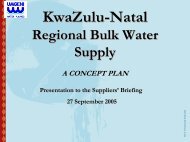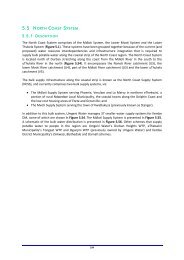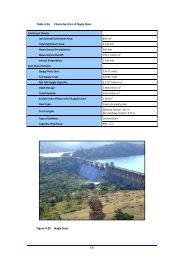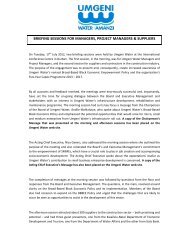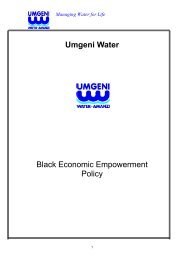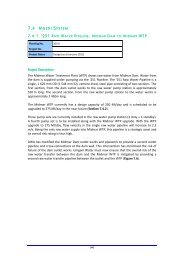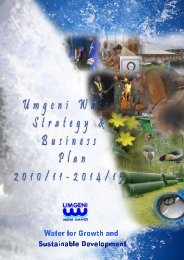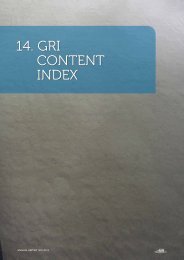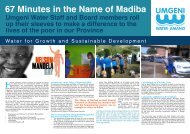e r 2 - Umgeni Water
e r 2 - Umgeni Water
e r 2 - Umgeni Water
- No tags were found...
You also want an ePaper? Increase the reach of your titles
YUMPU automatically turns print PDFs into web optimized ePapers that Google loves.
| Bank Accounts Chapter19.7 Analysis of Financial Risk<strong>Umgeni</strong> <strong>Water</strong> assumes a low risk tolerance approach to risk. The three risks described in the sections that followhave been identified as specific treasury risks and are managed proactively to ensure their timely mitigation.19.7.1 Sustainable TariffAn unsustainable tariff will affect <strong>Umgeni</strong> <strong>Water</strong>’s ability to fund future capital expenditure programmesand undertake operational expansion. This risk impacts on the organisation’s ability to deliver on itsfinancial strategies, namely, ‘Contribute to an Affordable Tariff’.Mitigation approach<strong>Umgeni</strong> <strong>Water</strong> monitors and reports on cash flow funding requirements and maintains optimal debtlevels, has a transparent and formalised tariff policy, together with a robust tariff model. The organisationundertakes water demand planning, liaises with stakeholders to obtain commitment to the capitalexpenditure programme and subsequently undertakes project evaluation to assess sustainability of theprogramme.19.7.2 Liquidity RiskLiquidity risk will result in <strong>Umgeni</strong> <strong>Water</strong> being unable to raise sufficient funds in the required currencyand at the correct time to meet its financial obligations. This will impact on the organisation’s ability toachieve its financial strategies, namely, ‘Enhance Shareholder Value’.Mitigation approachTo mitigate liquidity risk, <strong>Umgeni</strong> <strong>Water</strong> has:• Short-term funding facilities to meet ongoing cash requirements for which facility options arein place with four banks (FNB, Standard, ABSA, Nedbank);• A Domestic Medium Note (DMTN) Programme has been established allowing for longer dateddebt such as bonds to be issued with relative ease;• Provided for a R 200 million cash buffer investment to cater for delayed payments by itscustomers;• A redemption strategy framework, which provides guidelines for managing the risksassociated with refinancing large debt maturities (such as the UG65 bond). The build-up in theredemption portfolio over a three-year period is: 10 % of the capital redemption value threeyears before maturity, 40 % two years before maturity, 75 % a year before maturity, and thebalance of 25 % is funded during the year of maturity; and• Borrowing limits approved by National Treasury, which are currently: R 2,800 million for F’10,and R 1,800million for F’11.19.7.3 Credit RiskCredit risk concentration will result in <strong>Umgeni</strong> <strong>Water</strong> being exposed to counter-party failure. This has thepotential to impact on the organisation’s ability to ‘Maintain an Optimal Debt Level, amongst its otherstrategies.Mitigation approach<strong>Umgeni</strong> <strong>Water</strong> will:• According to its Investment Policy, mitigate credit risk by conducting transactions only withcounter parties and issuers who satisfy soundly based and acceptable assessment processes, andonly after formal limits have been set. In addition, same-day settlement limits will be setwherever possible and/or strict settlement procedures set and adhered to, and• Continue monitoring of the credit quality of counterparties.<strong>Umgeni</strong> <strong>Water</strong> Five-Year Business Plan | 2011/2012 to 2015/2016 Page 147



